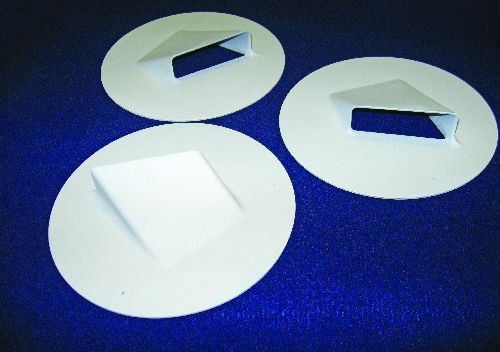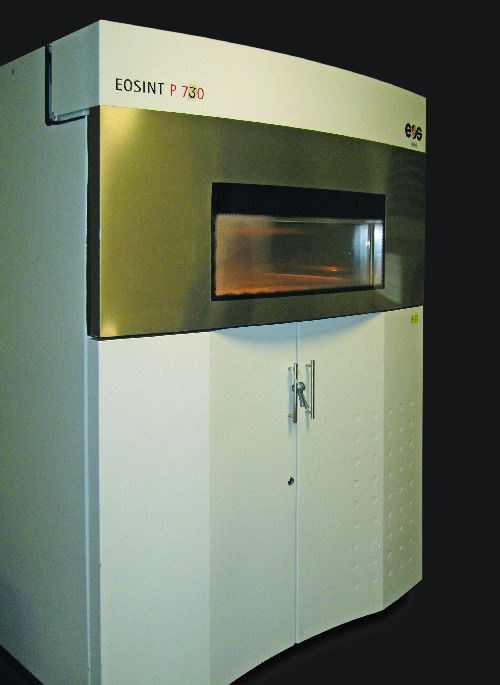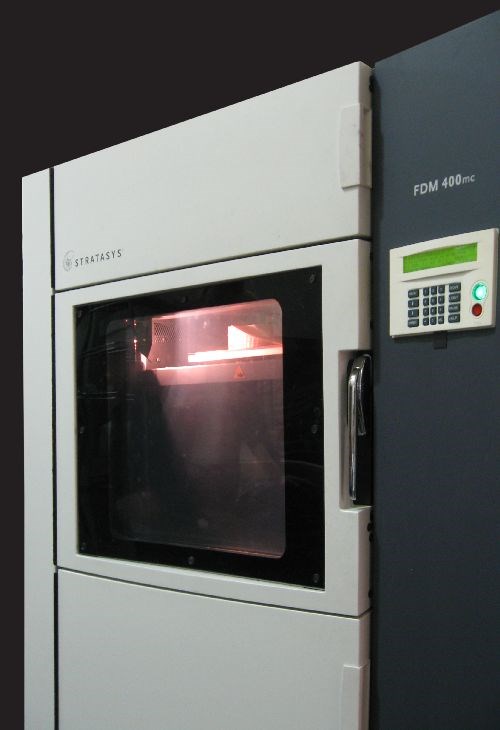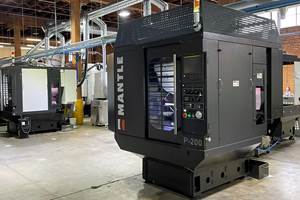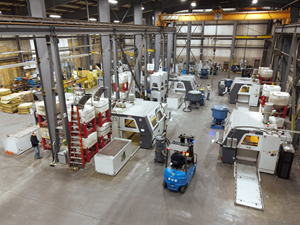The Aircraft Imperative
Reduce cost, reduce weight—to the extent that additive manufacturing can do these things, it represents a promising method for making aircraft parts. While important constraints currently prevent additive manufacturing from seeing more widespread use in aircraft production, these constraints might not be what you think. Here is a look at additive manufacturing within Boeing.
The Boeing Company’s Additive Manufacturing R&D group in St. Louis, Missouri makes prototypes practically every day. The group is a prototyping resource for the entire company. On the day I visited, one of this team’s additive machines was generating prototypes for helicopter components being designed in Philadelphia. CAD data would arrive in St. Louis and the corresponding plastic part would ship out less than 24 hours later.
This same group also makes fixture tooling. A rapid-response machine shop within the same building as the additive group is dedicated to making replacement parts for planes. Additive manufacturing often provides the fastest way to create a custom fixture for one of these one-off jobs.
However, neither prototypes nor tooling represent the true potential of additive manufacturing. Michael Hayes, principle design engineer with the Additive Manufacturing group, says that additive manufacturing processes need to go—and will go—far beyond their established applications. These processes that build complex forms layer by layer offer considerable promise not only to eliminate assembly steps, but also to reduce weight from aircraft designs in which every pound is important. One of his group’s responsibilities within Boeing is to help realize exactly this potential by finding cases in which additive manufacturing might be the best process for producing an end-use component for the finished aircraft.
To be sure, there are obstacles to applying additive manufacturing as a production process in this way. Those obstacles might not be what you would expect. Hayes, as well as David Dietrich, an engineer in the group who focuses on metal additive processes in particular, says that control over material properties is certainly an important issue. Additive processes do not yet offer the part-to-part consistency that critical aircraft parts require. Another issue is accuracy. In metal, the precision of additive processes is not yet sufficient to produce a part that can meet tight tolerances without further processing. Yet neither of these challenges is among the most critical constraints, the two men say. Further process innovation and refinement of the additive machines can clear these hurdles. Instead, the more confining constraints to the application of additive manufacturing today are much simpler. Namely, (1) the machines are too expensive and (2) the machines are too small.
Dietrich elaborates. He says the purchase price of an additive metal part-making machine is high enough that it forces him to seek only certain types of applications for additive production. The additive process cannot merely offer savings, which it often does. Instead, additive production has to offer dramatic savings in order to justify the equipment investment.
Meanwhile, Hayes says the small build envelope that is typical of the most proven additive equipment rules out the majority of aircraft parts that might benefit from this production. He notes that the best argument for additive manufacturing often involves a monolithic structure—an argument that obviously tends to favor larger components.
Still, the very fact that these are the significant limitations actually highlights additive manufacturing’s promise and suggests how near that promise is. If additive manufacturing equipment makers can engineer cost out of their machines, and if they can scale up these machines to produce larger work, then the way will be clear for additive production to command a much larger share of the ways that aircraft parts are made.
Fighter Ducts
Additive production already is being used for certain Boeing parts. Various ducts within the forward fuselage of the F/A-18 Hornet fighter aircraft have been produced on additive machines for 10 years. These intricate ducts were formerly made from aluminum in order to keep the weight light, even though aluminum is notoriously difficult to weld. Today, no welding is required to create the ductwork. What used to be welded assemblies are now produced in single pieces on machines that “grow” the complex forms out of engineered plastic.
These ducts carry nothing but air. Hayes says he does not foresee the day soon when laser sintering or similar additive processes will produce structural members that carry the weight of the plane. More material-property improvement and more validation of materials is needed before that can happen. However, this still leaves plenty of non-critical parts that ought to be obvious choices for additive production. An example that Hayes happened to be looking at before I met with him involved an access hatch within an aircraft cockpit. This part is just a door, but a complex door. Producing the hatch entirely through additive manufacturing would eliminate the need to machine separate components of the door and then assemble the components, and would therefore eliminate the fixtures and jigs related to machining and assembly. Making the hatch this way probably would also cut the weight in half. Hayes says the question with this part is not whether additive manufacturing would offer cost savings, but whether the cost savings would be high enough.
Combine and Conquer
According to Dietrich, all the successful part-production applications of additive manufacturing, whether in metal or plastic, tend to share something in common. That is, they usually involve replacing an assembly with a single piece. This is an crucial point, he says.
Additive manufacturing is unaffected by complexity. No matter how much detail the part has, the cycle time is nearly the same. Plus, unlike the subtractive process of machining, the additive process of building a part in layers is able to create complex forms on the inside of the part just as easily as on the outside. As a result, the most efficient uses of additive production involve generating a single-piece structure as an alternative to building the same structure by piecing together smaller components.
Dietrich routinely stresses this point to other Boeing engineers. Additive production will generally lose an apple-to-apple comparison against producing a single component through machining, he says. But it wins the apple-to-bushel comparison when it can produce what used to be an assembly of several parts.
Engineers designing satellites recently contacted him to ask if a particular part could be made through additive production. It could. But Dietrich asked, “How about sending me the components connected to it as well? Why don’t we just make them all in one piece?” The engineers had not considered that possibility, he says. Finding the freedom provided by additive manufacturing requires precisely this mindset change. Hayes, Dietrich and the other members of their group all hope to spread that mindset change to engineers throughout Boeing who are creating the company’s next-generation aircraft.
Additive’s Arrival
So far, satellites account for much of the success in applying additive production specifically to metal parts. Satellite components are small and complex—two traits well-suited to additive processing. In plastic, additive production has proceeded further, finding applications on defense aircraft. Additive production will have truly arrived when many more metal and plastic parts are produced this way, on defense planes and passenger planes both.
When that happens, Hayes says, additive manufacturing will have arrived not just for Boeing or the aerospace industry, but for manufacturing overall. That’s because aircraft production is arguably the most demanding major manufacturing sector. Production components here are manufactured to tight tolerances and certified to exacting standards. Not only that, “Take a look around—our parts are huge,” Hayes says, as he motions to the large fixtures and machine tools that are easily apparent in the St. Louis facility. Aircraft manufacturing is where extremes of precision, performance and size all come together.
As a result, there is something of a “New York, New York” quality to the advance of additive production within Boeing. If additive manufacturing can make it here, it will make it anywhere.
For Boeing’s part, the company is committing staff and resources to the belief that additive manufacturing will make it here. The expectation of the team in St. Louis—indeed, the very purpose of this team—is that additive manufacturing will take its rightful place as yet another mainstream method for producing aircraft parts.
Related Content
Mantle: 3D Printed Molds Address Plastics Industry Lead Time and Skills Shortage
Company now shipping production systems. Steel mold tooling from its TrueShape process can be printed, shaped and sintered in days, and with fewer steps, compared to weeks of lead time for molds made conventionally.
Read MoreLooking to Secure the Supply Chain for Castings? Don't Overlook 3D Printed Sand Cores and Molds
Concerns about casting lead times and costs have many OEMs looking to 3D print parts directly in metal. But don’t overlook the advantages of 3D printed sand cores and molds applied for conventional metal casting, says Humtown leader.
Read MoreCopper, New Metal Printing Processes, Upgrades Based on Software and More from Formnext 2023: AM Radio #46
Formnext 2023 showed that additive manufacturing may be maturing, but it is certainly not stagnant. In this episode, we dive into observations around technology enhancements, new processes and materials, robots, sustainability and more trends from the show.
Read MoreRobot Vs. Gantry for Large-Format Additive Manufacturing (Includes Video)
Additive Engineering Solutions, specialist at 3D printing very large parts and tools on gantry machines, now also uses a robot for large-format AM. Here is how the robot compares.
Read MoreRead Next
Bike Manufacturer Uses Additive Manufacturing to Create Lighter, More Complex, Customized Parts
Titanium bike frame manufacturer Hanglun Technology mixes precision casting with 3D printing to create bikes that offer increased speed and reduced turbulence during long-distance rides, offering a smoother, faster and more efficient cycling experience.
Read MoreAlquist 3D Looks Toward a Carbon-Sequestering Future with 3D Printed Infrastructure
The Colorado startup aims to reduce the carbon footprint of new buildings, homes and city infrastructure with robotic 3D printing and a specialized geopolymer material.
Read MorePostprocessing Steps and Costs for Metal 3D Printing
When your metal part is done 3D printing, you just pull it out of the machine and start using it, right? Not exactly.
Read More


